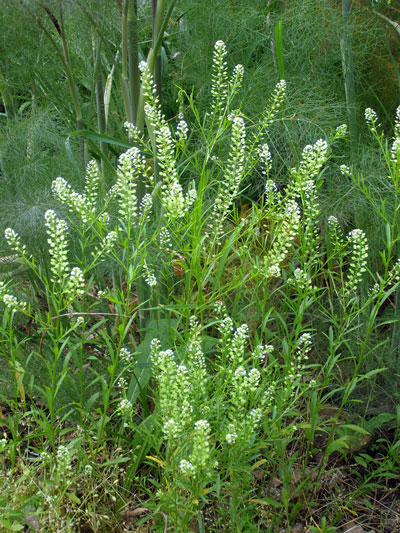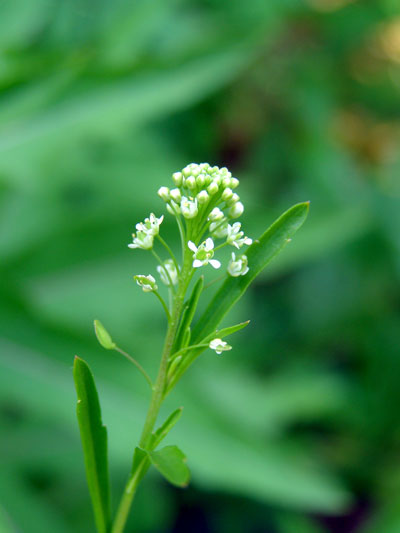Peppergrass
By Ken Moore
Flora Columnist
This week, I’m spicing up my yucca flower dishes (see last week’s Flora) with peppergrass harvested from the edge of the drive.
I’ve recognized peppergrass for years, but only this year have I taken a close-enough look to really value it. As long as I can remember, whenever I’ve seen the 1- to 2-foot-high stems with flat, round seed pods, I’ve remembered the plant and, though I’ve tasted its spicy flavor numerous times, I’ve just not given it serious consideration.
Perhaps the long, cool spring made me more observant this year. Several weeks ago, my eye was caught by tiny white flowers at the tops of rather nondescript weedy green plants growing along the drive. They had just begun flowering, and the characteristic flat, round seed capsules were not evident.
This time, I needed my trusty hand lens, which of course I always have in my pocket, to take a “closer look.†When I discerned four separate petals and six stamens, two of which were shorter than the other four, I immediately thought of the mustard family, the Cruciferae or Brassicaceae, depending on the botanical reference you may have at hand.
To verify my hunch, I reached down to taste a couple of leaves from the stem. The spicy, peppery taste is characteristic of the many native and exotic mustards we have so casually scattered throughout our yards and gardens.
It was easy to flip through images of the mustard family to identify this peppergrass, Lepidium virginicum, also called pepperweed. It’s definitely not a grass, though some may consider it a “weed.†I suspect earlier folks adopted these names because it tastes like pepper and is commonly found growing in fields with grasses and so-called “weeds.†Another name is poor man’s pepper, which makes sense if you consider relying on it in place of the store-bought spice.
Ethnobotanist Jim Duke enjoys nibbling the stem tops, including young leaves, fruit and flowers. I suggested this to a friend last week, and the surprise response was, “Sorta tastes like horseradish!†I’ve enjoyed adding the spicy plant tips fresh on salads and during the last stages of making omelets, sauces and soups.
Peppergrass is a natural source of protein and vitamins A and C and, if you do a little herbal sleuthing, you’ll find past and present medical uses.
This has been a most productive peppergrass season, and where there may be ample moisture, it will carry on through the fall. Look for it along walkways and edges of fields and forests in and around town. You probably have some savvy friends who may share some from their yards and gardens. If you don’t care to harvest any, pause in watchful contemplation. Peppergrass is a larval host plant for the checkered white butterfly, among others.
Email Ken Moore at flora@carrborocitizen.com.
Find previous Ken Moore Citizen columns at The Annotated Flora.
Comments are closed.





The plants make great model train layout trees. Strip the leaves and bundle together. Can this be grown in Akron, Ohio?
I have a sample of a tree from a train layout in Michigan. They said they buy huge quantities from a dealer in Colorado. Am I right to assume the stems turn brown and rigid in the fall. Do you know of a dealer in Ohio?
Thxs